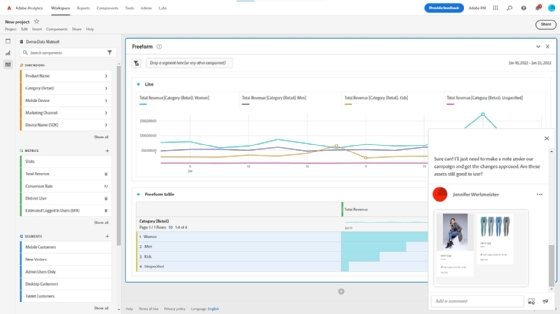
Getty Images/iStockphoto
Adobe Experience Cloud messaging collaboration in the works
Adobe reveals potential roadmap features in development, which include a chat client that might span Adobe Experience Cloud apps and foster collaboration across teams.
Adobe previewed a new feature on its roadmap -- a cross-team collaboration chat client dubbed Project Quick Connect that may eventually be embedded across Adobe Experience Cloud and Adobe Workfront.
In the Project Quick Connect use case Adobe presented, a retail data analyst could use the feature to spot a sales trend in Adobe Analytics and discuss next steps with a marketer to take advantage of the insight in an upcoming campaign. Chat threads can be documented in both Adobe Analytics annotations or within Workfront so that teams have a record of the conversations and actions taken within them.
"It's clearly aimed at bridging a classic insight-to-action gap in the enterprise," said Benjamin Bloom, a Gartner analyst. "If you think about what an analyst is trying to accomplish, they want the organization to make a decision -- to take data and turn it into something that they will do differently based on that insight. But it's incredibly challenging for that to happen in just one tool. So, potentially, this is assisting or bridging some of that gap with a workflow."
Product of 'Garage Week'
The idea came from engineers during "Garage Week," an internal hackathon where Adobe coders work on pet projects, said Jennifer Werkmeister, Adobe Analytics senior product manager. Embedding the chat client -- and its documentation features -- across the entirety of Adobe Experience Cloud in the future would be a challenge, and its completion would depend on user demand and other product priorities.

The feature was shown as part of Adobe Sneaks, one of the most popular sessions at Adobe Summit, the annual user conference held virtually this year. Things shown in Sneaks sessions aren't production-ready and don't always show up later as features in Adobe products -- but many do.
The chat feature was originally envisioned with senior decision-makers in mind, Werkmeister said.
"Everything is done through their mobile devices," Werkmeister said. "A lot of times it's on email. Now, if you've ever tried to open a report -- like a PowerPoint or an Excel -- on your phone, it sucks. You can't get stuff from that. So you have analysts struggling to fit this into an email in a way that's going to be mobile-friendly. It's a royal pain and a lot of time lost. It's communication lost as well."
Having a chat client embedded in the Adobe Experience Cloud environment saves clicks and the app-switching involved to show data points in Slack or other collaboration channels, she said. It presents data in a more readable rendering.
Adobe's healthcare cloud debuts
In other news, Adobe Experience Cloud for Healthcare, previewed last fall, is now generally available. It connects Adobe's customer data platform to Experience Cloud with HIPAA-ready data security and allows healthcare providers to manage patient communications, such as appointment reminders and care management content.
For insurance companies, Adobe's healthcare cloud can be configured to make recommendations for in-network providers, as well as keep tabs on customer service issues and wellness programs. For pharmacies, the healthcare cloud can manage prescription refill reminders and automate consumer offers to build loyalty.
It comes at a time when large customer experience technology vendors are battling for business in healthcare: Salesforce continues to build its healthcare cloud, as does Microsoft. Oracle made the biggest healthcare play of all, buying electronic medical records vendor Cerner late last year for $28.3 billion.
Don Fluckinger covers enterprise content management, CRM, marketing automation, e-commerce, customer service and enabling technologies for TechTarget.








